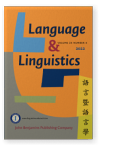Vol. 23:4 (2022) ► pp.743–777
Formation of Modern Chinese speech-quotative nǐ shuō ‘you say’ and feedback-seeking nǐ shuō ‘you tell me’
Two grammaticalizational pathways
In Modern Chinese, four construction types involving nǐ shuō may be distinguished. In this study, it is argued that the prosodically unseparated speech-quotative nǐ shuō (S1) develops from the prosodically separated speech-quotation nǐ shuō (S3) through a hypothesized complementation pathway which makes the nǐ shuō predicate the matrix clause of the following content clause. Prosodically unseparated feedback-seeking nǐ shuō (S2), in contrast, develops from a prosodically separated feedback-seeking nǐ shuō (S4) via a hypothesized conjoining pathway which involves the loss of a prosodic gap between the feedback-seeking nǐ shuō predicate and the clause that it occurs with. Contrary to the common assumption in the literature, S2 does not develop from S1. Meaning difference influences the selection of each of the two pathways, and in the source construction when an S3 or S4 is prosodically separated from the clause it occurs with, it is not the matrix clause of the latter. The account given in this study may also be used to explain the formation of English parenthetical predicate you say.
Article outline
- 1.Introduction
- 2.Literature review
- 3.Modern Chinese nǐ shuō predicates
- 4.Matrix clause perspective or parenthetical perspective
- 5.Discussion
- 5.1Hypothesized complementation pathway and formation of speech-quotative nǐ shuō (S1)
- 5.2Hypothesized conjoining pathway and formation of feedback-seeking nǐ shuō (S2)
- 5.3Selection of the pathways
- 6.Conclusion and further comments
- Acknowledgements
- Notes
- Abbreviations
-
References
For any use beyond this license, please contact the publisher at [email protected].
